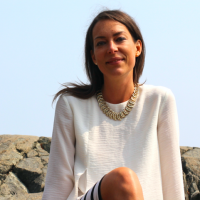
I hadn’t realized this, but the bleached and deserted underwater cemetery that I was swimming through was not in its natural state.
There was a phenomenon occurring in the northeast waters of Australia that caused 60 percent of the coral on the Great Barrier Reef to die. This event was called ‘bleaching’ and in 2002 I was vacationing right in the middle of it. Being an 18-year-old adventure-seeking soul, I had left my job in Sydney, Australia to travel up the coast before heading onto New Zealand.
What I had expected to find up at the remote tip of Australia, in a town called Port Douglas, was fish and colourful, vibrant coral. What met me in the waters there was something entirely different.
A girlfriend and I had managed to rub elbows with one of the crew of an antique junk boat in town. We slept on the boat at night and would sneak off in the morning before the customers arrived to head out on their daily reef tours.
When they weren’t busy on the junk, we were invited to go out to see the Great Barrier Reef. The first time I went, I was shaking inside of my borrowed, ill-fitting plastic, flippers and snorkel. I couldn’t wait to be amazed by the colours and sights of one of the seven natural wonders of the world.
I obediently lowered myself into the waters instead of plunging, but something eerie occurred. I wasn’t surrounded by abundant sea life, actually there seemed to be nothing alive down there at all.
I thought perhaps it was just that location, but I spent the morning searching for other places of movement or vibrancy and found none—accept for one grey, lost-looking fish.
As a young nomad, I wasn’t very plugged in. I had not realized that what was occurring there was a significant, widespread environmental hazard caused by global warming and pollutants—I thought we had just been dropped off at the wrong reef. Since we were getting the tour for free, I didn’t bring up my disappointment or dismay.
Fourteen years later, the very same thing that was happening then on the Great Barrier Reef, is occurring now. Coral bleaching is back and this time scientists say it has damaged up to 90 percent of the reef in northern Australia.
Coral bleaching occurs when the relationship between the reef and teeny zooxanthellae algae becomes disrupted. These algae live in the tissues of coral and are what give it nearly a 100 percent of its nutrients and color.
When ocean conditions change drastically—heat up or become acidic—these algae hit the road. Left without this symbiotic relationship, the coral turns white and has an extremely low chance of survival.
This was exactly what I had seen when I was 18, an ocean of dying coral.
The thing about coral reefs is that they protect us. They create a unique ecosystem for over 25 percent of the oceans animals and they shelter our shores from giant waves and storms. No coral means no fish and an extremely vulnerable coastline.
The two main reasons these bleaching’s are occurring are increased green house gasses causing global and ocean warming and water pollutants .
There is a gem to be found in this sad news though. We can do something!
Action’s to Save our Coral—Reducing our Carbon Footprint and Pollutants 101:
- Shop local—think neighborhood markets, produce and goods.
- Walk, bike or bus when possible.
- Plant things with deep roots (trees and shrubs) to stop poisonous run-off into our oceans.
- Eliminate our use of chemical fertilizers and pesticides.
- Share this issue with loved ones—awareness sparks change!
When it comes to our environment, we can no longer isolate parts of the world from one another. What is happening in a certain country affects everyone. Weather systems, pollutants and animals do not honour borders. What we do today in our own backyard matters. I may not be swimming in Australia’s waters this year, but I know I can do something to support from my home. Today, I choose to bike to my local café and eat a salad grown from a farm in town—spread the news, the coral needs to return.
~
Author: Sarah Norrad
Editor: Caitlin Oriel











Read 19 comments and reply